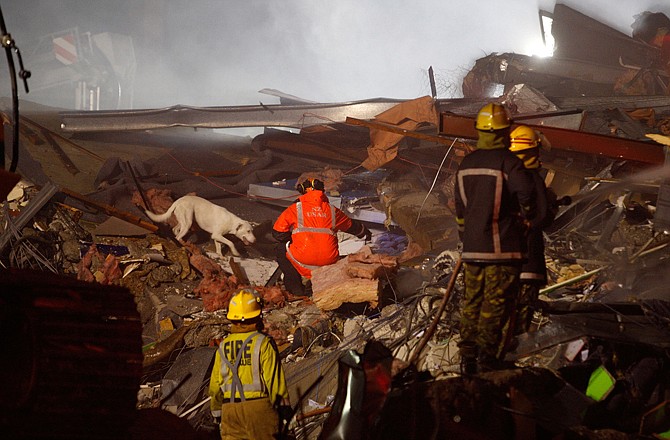CHRISTCHURCH, New Zealand (AP) - Some screamed from inside collapsed buildings. One woman used her mobile phone to call her children to say goodbye. Others tapped on the rubble to communicate with those on the outside.
Search teams using their bare hands, dogs, heavy cranes and earth movers worked frantically on Wednesday in one of New Zealand's largest cities to find survivors of a powerful earthquake as officials raised the death toll to at least 75.
Rescuers pulled nearly three dozen survivors from amid the crumbled concrete, twisted metal and huge mounds of brick across Christchurch.
Officials feared that the death toll could rise further, ranking the 6.3-magnitude earthquake among the island nation's worst in 80 years. They say at least 100 more people are missing.
"There are bodies littering the streets, they are trapped in cars, crushed under rubble and where they are clearly deceased our focus ... has turned to the living," police Superintendent Russell Gibson said.
Asked how many may still be trapped, he said: "It could be another hundred - it could be more."
Gibson said 39 bodies had been identified at a temporary morgue at the central police station. Prime Minister John Key said at least 75 people had been killed, and Gibson said the final figure "will be considerably higher than that."
Rescuers are concentrating on at least a dozen buildings that collapsed or were badly damaged. Urban search and rescue coordinator Paul Burt said at least 32 trapped people had been rescued from collapsed buildings overnight, and several more bodies had also been recovered.
Some survivors have emerged without a scratch, while others had to have a limb amputated before they could be freed.
Medical workers brought the injured to a triage center set up in a park in central Christchurch, while military units patrolled near-empty streets disfigured by the huge cracks and canyons created in Tuesday's quake, the second powerful temblor to hit the city in five months.
The quake toppled the spire of the city's historic stone cathedral, flattened tall buildings and sent chunks of concrete and bricks hurtling onto cars, buses and pedestrians below.
"People were covered in rubble, covered in several tons of concrete," said web designer Nathaniel Boehm, who was outside on his lunch break when the quake struck just before 1 p.m. He saw the eaves of buildings cascade onto the street, burying people below.
"It was horrific," he said.
The multistory Pyne Gould Guinness Building, housing more than 200 workers, collapsed. Rescuers, many of them office workers, dragged severely injured people out. Many had blood streaming down their faces. Screams could be heard from those still trapped inside.
The earthquake knocked out power and telephone lines and burst pipes, flooding the streets with water.
Firefighters climbed ladders to pluck people trapped on roofs of office towers to safety. Plumes of gray smoke drifted into the air from fires burning in the rubble, and helicopters used giant buckets to drench them with water.
The quake even shook off a massive chunk of ice from the country's biggest glacier some 120 miles east of Christchurch.
Christchurch's airport reopened for domestic flights on Wednesday. Military flights were being added to move tourists to other cities.
Thousands of people in the city moved into temporary shelters at schools and community halls. Others, including tourists who had abandoned their hotels, huddled in hastily pitched tents and under plastic sheeting as drizzling rain fell, while the Red Cross tried to find them accommodation.
Christchurch Mayor Bob Parker said 300 people were listed as missing but cautioned that they did not know the number trapped in collapsed buildings. More than 400 rescue workers were joining the search, including teams from Australia, Singapore, Taiwan, the United States and Britain.
Some who were trapped were able to call out using their mobile phones, reaching family, officials and media.
"I rang my kids to say goodbye," said Ann Voss, interviewed by TV3 from underneath her desk where she was trapped in a collapsed office building. "It was absolutely horrible. My daughter was crying and I was crying because I honestly thought that was it.
"You know, you want to tell them you love them don't you?"
Voss said she could hear other people still alive in the building and had called out to them and communicated by knocking on rubble.
"I'm not going to give up," she said. "I'm going to stay awake now. They better come and get me."
Moments after the quake struck, dazed, screaming and crying residents wandered the streets as sirens and car alarms blared. With ambulance services overwhelmed, some victims were carried to private vehicles in makeshift stretchers fashioned from rugs or bits of debris.
A U.S. delegation of 43 government, business and community leaders was in Christchurch for a United States New Zealand Partnership Forum meeting. All were safe. Nine U.S. Congressmen attending the meeting were reported to have left the city before the quake struck.

